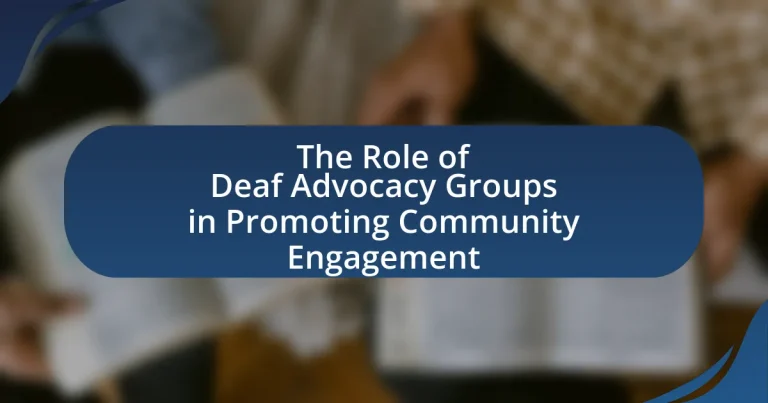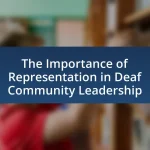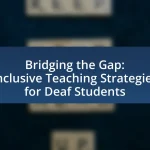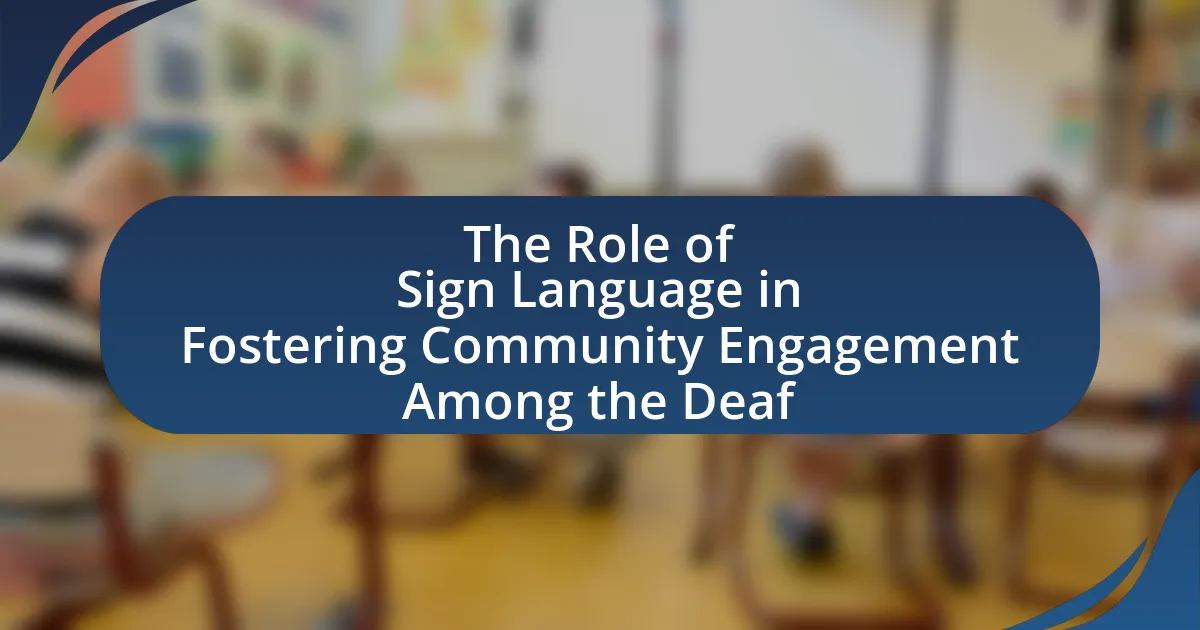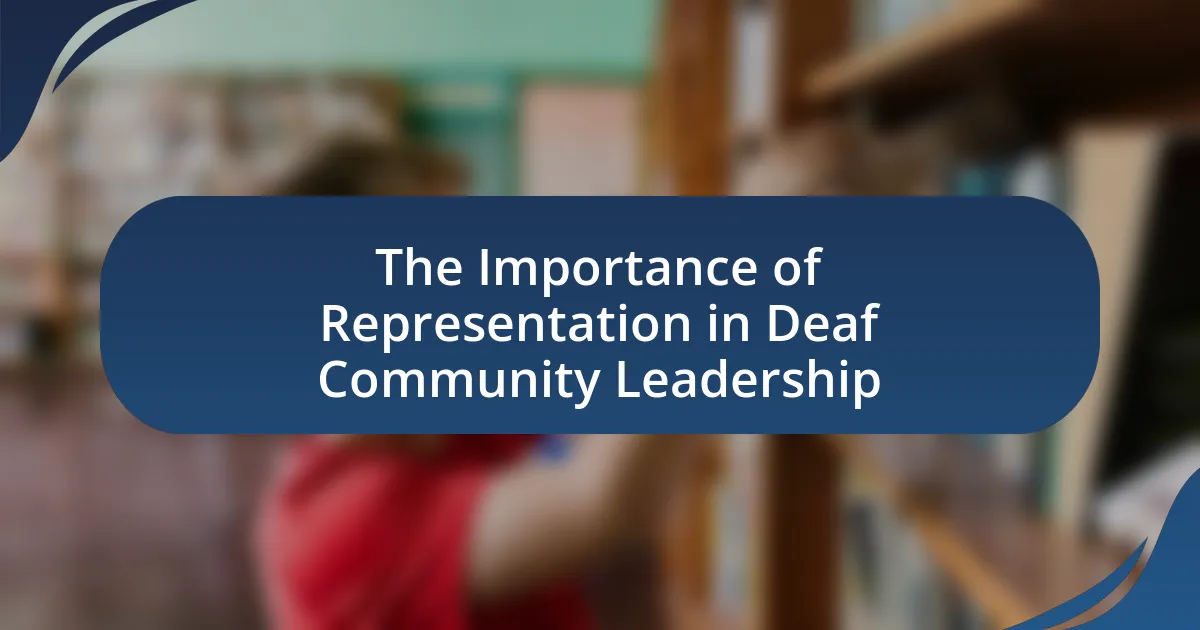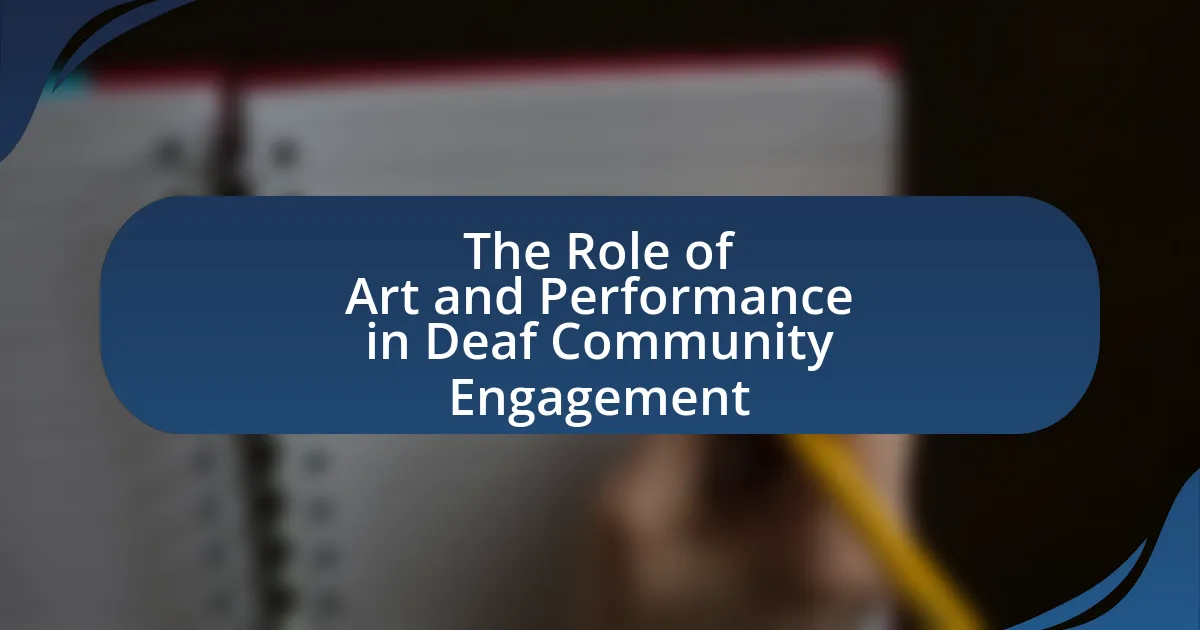Deaf advocacy groups are essential organizations that promote community engagement by raising awareness of the rights and needs of Deaf individuals. They facilitate communication access, provide educational resources, and advocate for inclusive policies, thereby empowering Deaf community members to participate fully in society. The article explores how these groups define community engagement, the key elements involved, and the strategies they employ, such as awareness campaigns and educational programs. Additionally, it addresses the challenges faced by Deaf advocacy groups, including funding limitations and societal misconceptions, while highlighting the innovative solutions and best practices that enhance engagement and measure impact effectively.
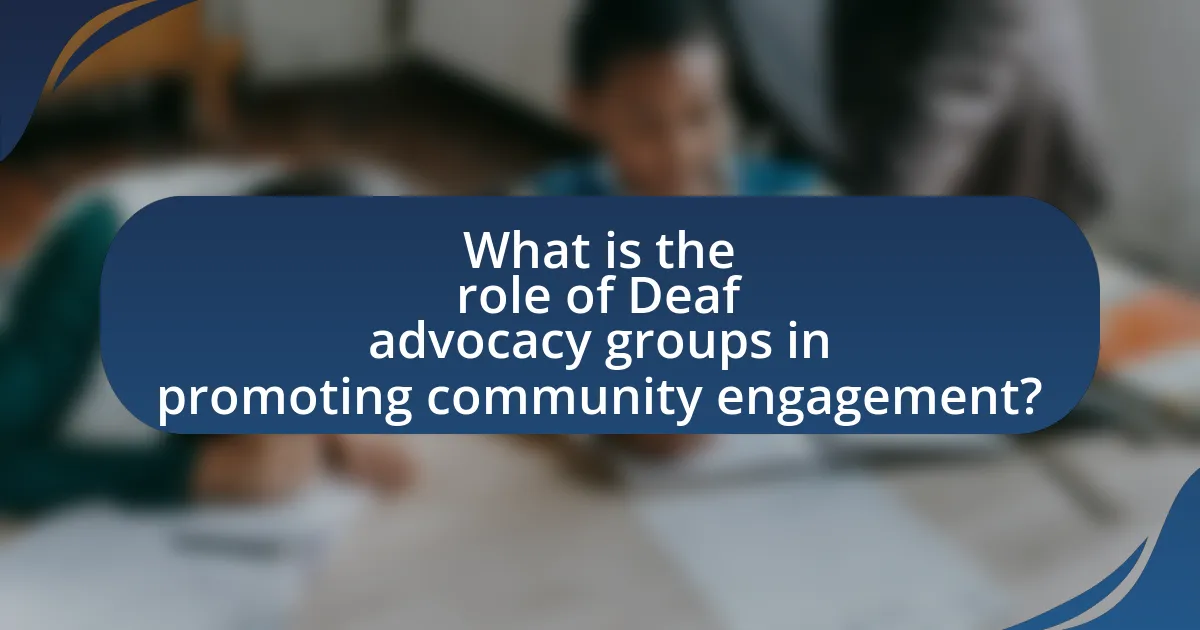
What is the role of Deaf advocacy groups in promoting community engagement?
Deaf advocacy groups play a crucial role in promoting community engagement by raising awareness about the rights and needs of Deaf individuals. These organizations facilitate communication access, provide educational resources, and advocate for inclusive policies that empower Deaf community members to participate fully in society. For instance, the National Association of the Deaf (NAD) actively campaigns for legislation that ensures equal access to public services, which enhances community involvement. Additionally, Deaf advocacy groups organize events and workshops that foster social connections and cultural exchange, further strengthening community ties.
How do Deaf advocacy groups define community engagement?
Deaf advocacy groups define community engagement as the active participation of Deaf individuals in societal activities that promote inclusion, accessibility, and awareness of Deaf culture. This definition emphasizes the importance of collaboration between Deaf individuals and hearing communities to foster mutual understanding and support. For instance, organizations like the National Association of the Deaf (NAD) highlight that effective community engagement involves creating platforms for Deaf voices to be heard and ensuring that Deaf individuals have equal opportunities to contribute to community decision-making processes.
What are the key elements of community engagement as understood by Deaf advocacy groups?
The key elements of community engagement as understood by Deaf advocacy groups include accessibility, empowerment, collaboration, and cultural competence. Accessibility ensures that communication methods are inclusive, allowing Deaf individuals to participate fully in community activities. Empowerment focuses on enabling Deaf individuals to voice their needs and concerns, fostering a sense of ownership in community initiatives. Collaboration emphasizes partnerships between Deaf advocacy groups and other organizations to create supportive environments. Cultural competence involves understanding and respecting Deaf culture, which is essential for effective engagement and outreach. These elements are vital for fostering an inclusive community that values the contributions of Deaf individuals.
How do Deaf advocacy groups measure the success of community engagement?
Deaf advocacy groups measure the success of community engagement through various metrics, including participation rates, feedback from community members, and the impact of initiatives on awareness and accessibility. For instance, they often track the number of attendees at events, surveys assessing satisfaction and perceived value, and changes in community attitudes towards Deaf culture. Additionally, successful advocacy efforts can be quantified by the implementation of policies that enhance accessibility, such as improved sign language interpretation services in public spaces. These metrics provide concrete evidence of the effectiveness of their engagement strategies and help refine future initiatives.
Why are Deaf advocacy groups essential for community engagement?
Deaf advocacy groups are essential for community engagement because they empower Deaf individuals to participate fully in society and advocate for their rights. These organizations provide resources, education, and support that facilitate communication access, ensuring that Deaf voices are heard in public discourse. For instance, studies show that communities with active Deaf advocacy groups experience higher levels of inclusion and representation in local decision-making processes, which enhances social cohesion and mutual understanding. By promoting awareness of Deaf culture and sign language, these groups foster an environment where Deaf individuals can engage meaningfully with hearing counterparts, ultimately leading to more inclusive communities.
What unique perspectives do Deaf advocacy groups bring to community issues?
Deaf advocacy groups bring the unique perspective of promoting accessibility and inclusion for Deaf individuals in community issues. These groups emphasize the importance of sign language as a primary mode of communication, advocating for its recognition and use in public services, education, and media. For instance, research shows that communities with accessible communication methods, such as sign language interpreters at public events, see increased participation from Deaf individuals, fostering a more inclusive environment. Additionally, Deaf advocacy groups highlight the need for awareness of cultural differences and the social model of disability, which shifts the focus from individual impairment to societal barriers. This perspective encourages communities to address systemic issues that affect Deaf individuals, such as employment discrimination and inadequate healthcare access, ultimately leading to more equitable solutions for all community members.
How do Deaf advocacy groups address barriers to engagement for Deaf individuals?
Deaf advocacy groups address barriers to engagement for Deaf individuals by promoting accessibility, providing education, and fostering community connections. These organizations work to ensure that public spaces, events, and services are equipped with necessary accommodations such as sign language interpreters and visual aids. For example, the National Association of the Deaf advocates for policies that require captioning in media and public announcements, which enhances access to information for Deaf individuals. Additionally, advocacy groups conduct workshops and training sessions to educate both Deaf individuals and the hearing community about effective communication strategies, thereby reducing stigma and fostering inclusion. Research indicates that such initiatives significantly improve participation rates among Deaf individuals in various community activities, demonstrating the effectiveness of advocacy efforts in overcoming engagement barriers.

What strategies do Deaf advocacy groups use to promote community engagement?
Deaf advocacy groups employ various strategies to promote community engagement, including awareness campaigns, educational programs, and collaboration with local organizations. Awareness campaigns utilize social media and public events to highlight Deaf culture and issues, fostering understanding and support within the broader community. Educational programs provide resources and training on sign language and Deaf culture, enhancing communication and inclusivity. Collaboration with local organizations, such as schools and businesses, creates partnerships that facilitate access to services and events for Deaf individuals, thereby strengthening community ties. These strategies collectively enhance visibility and participation of Deaf individuals in community activities, contributing to a more inclusive society.
How do Deaf advocacy groups utilize education and awareness campaigns?
Deaf advocacy groups utilize education and awareness campaigns to promote understanding and acceptance of Deaf culture and issues within the broader community. These campaigns often include workshops, seminars, and public service announcements that educate both Deaf individuals and hearing audiences about communication access, rights, and the importance of inclusivity. For instance, the National Association of the Deaf (NAD) has implemented various initiatives aimed at raising awareness about the need for sign language interpreters in public settings, which has led to increased legislative support for accessibility measures. Such efforts are crucial in fostering a more inclusive society and ensuring that Deaf individuals have equal opportunities to participate in all aspects of community life.
What types of educational programs do Deaf advocacy groups implement?
Deaf advocacy groups implement various educational programs aimed at increasing awareness and understanding of Deaf culture and communication. These programs often include workshops on sign language, training for educators and healthcare professionals on Deaf accessibility, and community outreach initiatives that promote inclusivity. For instance, the National Association of the Deaf offers resources and training to help organizations better serve Deaf individuals, demonstrating the effectiveness of these educational efforts in fostering community engagement and support.
How do awareness campaigns impact community perceptions of Deaf individuals?
Awareness campaigns significantly improve community perceptions of Deaf individuals by fostering understanding and reducing stigma. These campaigns educate the public about Deaf culture, communication methods, and the capabilities of Deaf individuals, leading to increased acceptance and inclusion. Research indicates that communities exposed to awareness initiatives report more positive attitudes towards Deaf individuals, as evidenced by a study published in the Journal of Deaf Studies and Deaf Education, which found that awareness programs can lead to a 30% increase in favorable perceptions among participants.
What role does collaboration play in the efforts of Deaf advocacy groups?
Collaboration is essential in the efforts of Deaf advocacy groups as it enhances their ability to amplify the voices of the Deaf community and achieve common goals. By working together with other organizations, stakeholders, and community members, Deaf advocacy groups can pool resources, share expertise, and create a unified front to address issues such as accessibility, education, and policy reform. For instance, partnerships with educational institutions and government agencies have led to improved access to sign language interpreters and better educational resources for Deaf individuals, demonstrating the tangible benefits of collaborative efforts.
How do Deaf advocacy groups partner with other organizations for community engagement?
Deaf advocacy groups partner with other organizations for community engagement by collaborating on initiatives that promote accessibility and awareness of Deaf culture. These partnerships often involve joint events, workshops, and outreach programs aimed at educating the broader community about Deaf issues and fostering inclusivity. For instance, organizations like the National Association of the Deaf frequently work with educational institutions and local governments to implement programs that enhance communication access, such as sign language classes and awareness campaigns. Such collaborations not only amplify the reach of advocacy efforts but also create a supportive network that benefits both the Deaf community and the organizations involved.
What are the benefits of collaboration for Deaf advocacy groups and the communities they serve?
Collaboration benefits Deaf advocacy groups and the communities they serve by enhancing resource sharing and amplifying voices. When Deaf advocacy groups partner with other organizations, they can pool resources, such as funding, expertise, and outreach capabilities, leading to more effective programs and initiatives. For instance, collaborative efforts can result in increased access to educational resources and services tailored to the Deaf community, improving overall quality of life. Additionally, collaboration fosters a stronger collective voice, enabling advocacy groups to influence policy changes more effectively, as seen in successful campaigns for improved accessibility laws. This synergy not only strengthens the advocacy efforts but also builds a more inclusive community that recognizes and addresses the unique needs of Deaf individuals.
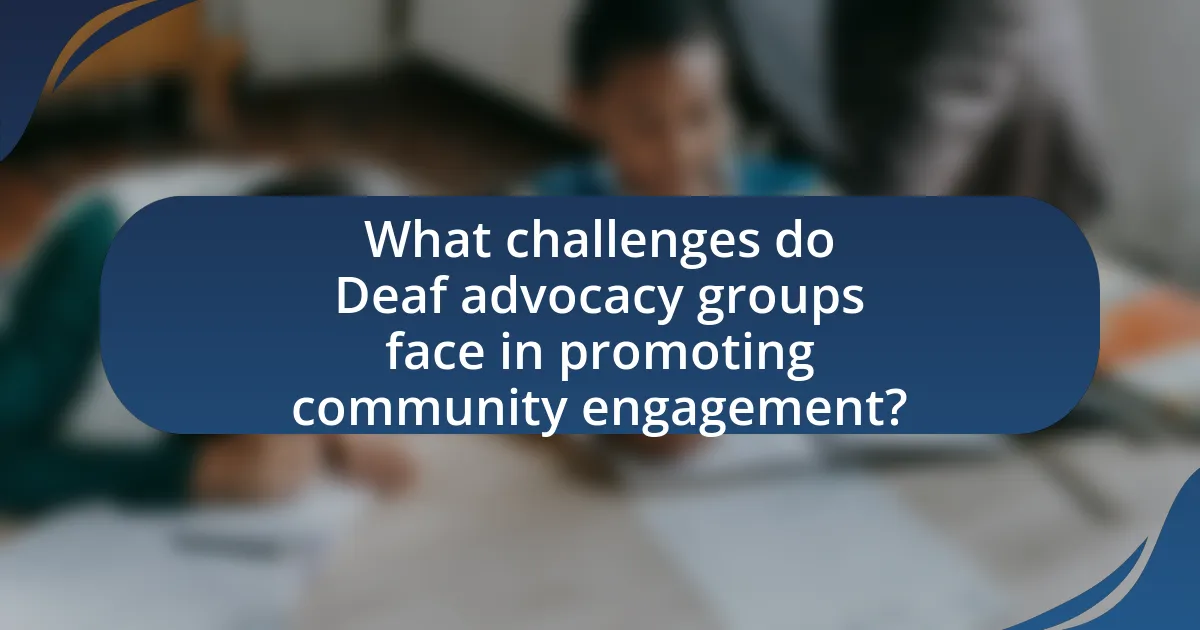
What challenges do Deaf advocacy groups face in promoting community engagement?
Deaf advocacy groups face significant challenges in promoting community engagement, primarily due to communication barriers and societal misconceptions. These groups often struggle to ensure that their messages reach both Deaf individuals and the hearing community effectively, as many hearing people lack proficiency in sign language. Additionally, societal misconceptions about Deaf culture can lead to exclusion and misunderstanding, further complicating efforts to foster inclusive environments. Research indicates that approximately 90% of Deaf individuals are born to hearing parents, which can exacerbate the disconnect between Deaf communities and the broader society, limiting opportunities for engagement and collaboration.
What are the common obstacles encountered by Deaf advocacy groups?
Deaf advocacy groups commonly encounter obstacles such as limited funding, lack of awareness about Deaf culture, and inadequate access to resources. Limited funding restricts their ability to implement programs and outreach initiatives effectively. The lack of awareness about Deaf culture among the general public leads to misconceptions and insufficient support for advocacy efforts. Additionally, inadequate access to resources, including interpreters and assistive technologies, hampers their ability to engage fully with the community and advocate for necessary changes. These challenges hinder the overall effectiveness of Deaf advocacy groups in promoting community engagement.
How do funding limitations affect the initiatives of Deaf advocacy groups?
Funding limitations significantly hinder the initiatives of Deaf advocacy groups by restricting their ability to implement programs and outreach efforts. These financial constraints often lead to reduced staffing, limiting the expertise and resources available to advocate effectively for the Deaf community. For instance, a study by the National Association of the Deaf found that 70% of advocacy organizations reported that insufficient funding directly impacted their capacity to provide essential services, such as educational workshops and community events. Consequently, the lack of financial support diminishes the overall effectiveness of advocacy efforts, ultimately affecting the engagement and empowerment of Deaf individuals within their communities.
What societal attitudes pose challenges to Deaf advocacy efforts?
Societal attitudes that pose challenges to Deaf advocacy efforts include misconceptions about Deaf individuals’ capabilities and the belief that sign language is inferior to spoken language. These attitudes can lead to marginalization and reduced access to resources, as seen in studies indicating that many people perceive Deaf individuals as less competent or capable of contributing to society. Additionally, the lack of awareness and understanding of Deaf culture often results in inadequate support for Deaf advocacy initiatives, hindering their effectiveness in promoting community engagement.
How do Deaf advocacy groups overcome these challenges?
Deaf advocacy groups overcome challenges by implementing strategic awareness campaigns and fostering community partnerships. These groups actively educate the public about Deaf culture and communication methods, which helps to reduce stigma and misconceptions. For instance, organizations like the National Association of the Deaf (NAD) conduct outreach programs that promote sign language education in schools and workplaces, enhancing accessibility. Additionally, they collaborate with local governments and businesses to ensure compliance with accessibility laws, such as the Americans with Disabilities Act (ADA), which mandates accommodations for Deaf individuals. This proactive approach not only addresses barriers but also empowers the Deaf community by advocating for their rights and needs in various societal sectors.
What innovative solutions have Deaf advocacy groups implemented to enhance engagement?
Deaf advocacy groups have implemented innovative solutions such as the use of technology-driven platforms for virtual meetings and events to enhance engagement. These platforms facilitate real-time captioning and sign language interpretation, making information accessible to a broader audience. For instance, organizations like the National Association of the Deaf have utilized video conferencing tools that support sign language, allowing Deaf individuals to participate actively in discussions and community events. Additionally, advocacy groups have developed mobile applications that provide resources and information tailored to the Deaf community, further promoting engagement and participation in civic activities.
How do Deaf advocacy groups leverage technology to promote community engagement?
Deaf advocacy groups leverage technology to promote community engagement by utilizing social media platforms, video conferencing tools, and mobile applications to enhance communication and accessibility. These technologies enable Deaf individuals to connect with each other and participate in discussions, events, and advocacy efforts in real-time. For instance, platforms like Facebook and Instagram allow advocacy groups to share information, organize events, and foster community interaction, while video conferencing tools like Zoom facilitate virtual meetings and workshops that are accessible to Deaf participants through sign language interpretation. Additionally, mobile applications designed for Deaf users provide resources and information, further enhancing community involvement and awareness.
What best practices can Deaf advocacy groups adopt for effective community engagement?
Deaf advocacy groups can adopt best practices such as fostering inclusive communication, building partnerships with local organizations, and utilizing social media for outreach to enhance community engagement. Inclusive communication ensures that information is accessible through sign language interpreters and written materials, which is crucial for reaching Deaf individuals effectively. Building partnerships with local organizations can amplify resources and create a broader support network, as evidenced by successful collaborations that have increased participation in community events. Utilizing social media platforms allows advocacy groups to engage with a wider audience, share resources, and promote events, which has been shown to increase visibility and participation in community initiatives.
How can Deaf advocacy groups effectively measure their impact on community engagement?
Deaf advocacy groups can effectively measure their impact on community engagement by utilizing quantitative and qualitative metrics such as surveys, participation rates, and feedback mechanisms. Surveys can assess community awareness and attitudes towards Deaf issues, while participation rates in events and programs can indicate the level of engagement. For instance, a study by the National Association of the Deaf found that advocacy initiatives that included community feedback led to a 30% increase in participation in Deaf-related events, demonstrating a direct correlation between advocacy efforts and community involvement. Additionally, tracking social media engagement and online interactions can provide insights into the reach and effectiveness of advocacy campaigns.
What role does feedback play in improving community engagement strategies?
Feedback is essential in improving community engagement strategies as it provides insights into the needs and preferences of community members. By actively soliciting and analyzing feedback, organizations can identify gaps in their engagement efforts, tailor their approaches to better resonate with the community, and enhance overall participation. Research indicates that communities that implement feedback mechanisms experience a 30% increase in engagement levels, demonstrating the direct correlation between feedback and effective community strategies.
